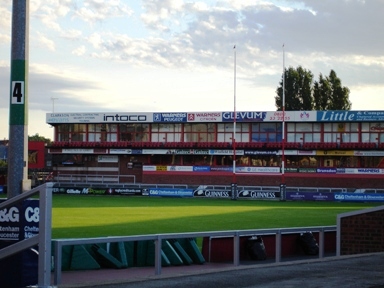|
|
|
History
Gloucester Football Club was formed on the September 13, 1873 following
an announcement in the Gloucester Journal. The famous 'Cherry and Whites'
jersey did not originally belong to the club. Painswick
RFC, based in Gloucestershire and the oldest village club, are the original
'Cherry and Whites'. After
Towards the 1920s Gloucester produced its first well know name in Tom Voyce, who was to be involved in the game for 54 years as
both a player and an a administrator. As well as playing for Glos, he also served in the Gloucester Regiment. Whilst
serving in the army, Tom would win 27 international caps and toured with the
Lions in
The Club was well served by several players who were recognised for their endeavours in the colours of Gloucester RFC by representing England – Harold Boughton, Alfred Carpenter, Percy Hordern, Maurice McCanlis, Graham Parker, Leslie Saxby, Christopher Tanner, were all honoured with wearing the white shirt of England. Sadly Christopher Tanner lost his life serving his country in the Second World War.
Gloucester Rugby Club has always fielded a renowned pack of forwards. In the
pre-war period during the 1930s the Club had six internationals and four
The dearth of players who could challenge for representative honours led to the Club becoming somewhat forward dominated in the following 25 year period. Off the field of play the Club could rightly claim that in the fifty-year period from the turn of the century it had produced three of the finest administrators the game had produced – Arthur Hudson, Arnold Alcock and Tom Voyce.
The 1950s commenced with the club introducing the first public address
system. The
On the field of play advanced tactical and skills training was introduced by
In 1972 the Club rejoiced in the fact that they had won the first ever
National knock-out competition defeating Moseley in the final at Twickenham by
17 points to 6. It was a match marred by the sending off of Nigel Horton of
Moseley.
the Team who played that day vs. Moseley: Alan Brinn, Mike Burton, John Bayliss, Mickey Booth, Robin Cowling, Bob Clewes, John Dix, Ron Etheridge, Jerry Herniman, Nigel Jackson, John Haines, Jim Jarrett, Richard Jardine, Roy Morris, Mike Nicholls, Dave Owen, Mike Bayliss, Mike Potter, Mike Burton, Tom Palmer, Richard Smith, Eric Stephens, John Watkins and Roy White.


